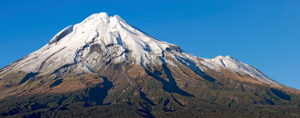
Photo Credit: Dave Young – CC-BY 2.0
While the details vary, the story of how Taranaki came to be is briefly as follows: originally the mountains of Te Ika-a-Māui [the North Island] lived at its centre. Taranaki fell in love with a beautiful female mountain, but she belonged to another. Distraught, he fled to the west, gouging out the Whanganui River as he went and filling it with his tears. Now he sits alone.
There are many other stories connected to Taranaki and this ancient name and mountain are of great importance to the local iwi (extended kinship group) and hapū (kinship group).
In January 1770, Cook described the mountain from the deck of the HMB Endeavour, seeing it through gaps in the clouds, writing ‘It is of a prodigious height and its top is cover'd with everlasting snow’. He applied the name ‘Mount Egmont’ to honour the Earl of Egmont, John Perceval, previously first Lord of the Admiralty. While he had supported earlier voyages of exploration, Perceval had retired by the time of Cook’s first voyage and had no direct connection with it. He died before learning of the honour.
In 1865, in the wake of the New Zealand Wars, the government confiscated the mountain and surrounding lands from the Taranaki and Te Ati Awa peoples.
The name ‘Egmont’ persisted on maps while the land was settled. In 1905, a Māori correspondent, ‘Tu Taranaki’, wrote to the local newspaper appealing for the retention of Māori names. They wrote:
You have set aside the land around Mount Taranaki for a National Park wherein may be preserved at least a little of our native flora; why then not preserve there our native names as well?
They gave the examples of ‘Te Rere a Noke’ for Dawson Falls and ‘Panitahi' for Fantham's Peak. While both Taranaki and Egmont were used on maps up until the 1930s, many Europeans gradually stopped using Taranaki.
In 1978, the mountain was returned to the Taranaki Maori Trust Board, who, by the same Act of Parliament, gifted the mountain to the nation. In 1983, the Board approached the New Zealand Geographic Board (NZGB) about restoring the name of Taranaki.
As required by legislation, the NZGB considered whether the name change met the naming criteria, including prioritising the original Māori name and avoiding duplications of place names.
On 6 August 1985, the NZGB approved the following resolution:
- That the name of the mountain revert to its original name ‘Taranaki’ but that the name ‘Egmont’ be continued as a secondary name in brackets.
- That the prefix ‘Mount’ be used in front of the name ‘Taranaki’ for mapping purposes.
- That the board agrees that it sees no reason for changing the name of other geographical features or locations such as Cape Egmont, Egmont Village and East Egmont.
The decision was notified to the general public. Over the next three months, the NZGB received 10,746 objections through six petitions, 127 letters from individuals and 29 objections from community organisations and local governments. Of the objections, 68 per cent came from people in Taranaki; the remainder came from throughout New Zealand and even a few from overseas.
Because of the controversy over the decision, the matter was then referred to the then Minister for Lands, Hon Koro Wetere. He decided that both names – Mount Taranaki and Mount Egmont – would become official.
In the early 2000s, the local paper Daily News was still using ‘Egmont’ when Lance Girling-Butcher became editor. Prompted by repeated, polite requests for change by local Māori and international reporting of an incident on the mountain, he told the sub-editors that ‘Taranaki’ would now be used instead.
Taranaki is now in widespread use.
References
- NZ Gazetteer - Mount Taranaki or Mount Egmont
- James Cook, ’13 January 1770’, South Seas: Voyaging and Cross-Cultural Encounters in the Pacific (1760-1800)
- ‘Report of the NZ Geographic Board to the Minister of Lands under Section 13…’, p. 11
- ‘Tu Taranaki’, ‘A Further Plea For Maori Names’, Hawera & Normanby Star, 9 June 1905, p. 2
- ‘Report of the NZ Geographic Board to the Minister of Lands under Section 13…’, pp. 3-4
- ‘ Putting history in its place: the move to Māori names’, Stuff